Tetrachlorodibenzodioxin
 |
|
 |
|
| Names | |
|---|---|
|
IUPAC name
2,3,7,8-Tetrachlorodibenzo[b,e][1,4]-dioxin
|
|
| Other names
Tetradioxin; Tetrachlorodibenzodioxin; Tetrachlorodibenzo-p-dioxin
|
|
| Identifiers | |
|
3D model (JSmol)
|
|
| Abbreviations | TCDD; TCDBD |
| ChEBI | |
| ChemSpider | |
| ECHA InfoCard | 100.015.566 |
| KEGG | |
|
PubChem CID
|
|
| UNII | |
|
|
|
|
| Properties | |
| C12H4Cl4O2 | |
| Molar mass | 321.96 g·mol−1 |
| Appearance | Colorless to white crystalline solid |
| Density | 1.8 g cm−3 |
| Melting point | 305 °C (581 °F; 578 K) |
| 0.2 µg/L | |
| log P | 6.8 |
| Vapor pressure | 1.5 × 10−9 mmHg |
| Hazards | |
| Main hazards | extremely carcinogen, teratogen |
|
EU classification (DSD) (outdated)
|
|
| R-phrases (outdated) | R26/27/28 R45 |
| S-phrases (outdated) | S36/37 S62 |
| NFPA 704 | |
| Flash point | 164.2 °C (327.6 °F; 437.3 K) |
| US health exposure limits (NIOSH): | |
|
PEL (Permissible)
|
none |
|
REL (Recommended)
|
Ca |
|
IDLH (Immediate danger)
|
N.D. |
|
Except where otherwise noted, data are given for materials in their standard state (at 25 °C [77 °F], 100 kPa).
|
|
|
|
|
| Infobox references | |
2,3,7,8-Tetrachlorodibenzo-p-dioxin (TCDD) is a polychlorinated dibenzo-p-dioxin (sometimes shortened, though inaccurately, to simply "dioxin") with the chemical formula C
12H
4Cl
4O
2. TCDD is a colorless solid with no distinguishable odor at room temperature. It is usually formed as a side product in organic synthesis and burning of organic materials.
TCDD is the most potent compound (congener) of its series (polychlorinated dibenzodioxins, known as PCDDs or simply dioxins) and became known as a contaminant in Agent Orange, an herbicide used in the Vietnam War. TCDD was released into the environment in the Seveso disaster. It is a persistent environmental contaminant usually present in a complex mixture of dioxin-like compounds, and is a carcinogen.
The Expert Group of the World Health Organization considered developmental toxicity as the most pertinent risk of dioxins to human beings. Because people are usually exposed simultaneously to a number of dioxin-like chemicals, a more detailed account is given at dioxins and dioxin-like compounds.
TCDD was classified in 1997 by the International Agency for Research on Cancer as a carcinogen for humans (group 1). In the occupational cohort studies available for the classification, the risk, even at very high exposures, was weak and borderline detectable. Therefore, human data were not deemed sufficient, and the classification was, in essence, based on animal experiments and mechanistic considerations. This has been criticized as a deviation from IARC classification rules. It is much debated whether TCDD is carcinogenic only at high doses which also cause toxic damage of tissues. Moreover, a recent review concludes that, after 1997, further studies do not support an association between TCDD exposure and cancer risk. New studies include the update of Vietnam veteran studies from Ranch Hand operation, which concluded that after 30 years the results do not provide evidence of disease.
...
Wikipedia

